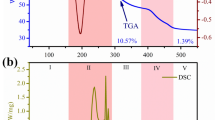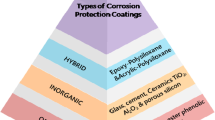Abstract
In this work, bio-based hybrid coating using Ag-TiO2 (AgT) sol and cardanol epoxy (CE) was developed, coated over mild steel (MS) substrates and studied for its corrosion resistant efficiency. Initially, the AgT sol was prepared and successively surface-functionalized using 3-glycidoxypropyl-trimethoxysilane (GPTMS) using a sol–gel approach to achieve compatible with the CE matrix. The physico-chemical and antimicrobial properties of neat CE and CE composites with different wt% of GAgT (GAgTx/CE) were studied using various analytical techniques and microbial assays, respectively. Further, CE and the GAgTx/CE composites were coated over MS, and their corrosion resistant behavior against microbial co-culture medium (MCM) (i.e. nutrient medium amended with 3% w/v NaCl and inoculated with both Micrococcus luteus and Pseudomonas aeruginosa) was evaluated by electrochemical techniques at different periods. The results suggested that the presence of GAgT along with CE matrix provided enhanced hydrophobicity with low surface free energy, which consequently lowered the interfacial interactions between the microbes and MS substrates. The optimum loading of GAgT in CE was 3 wt.%, showing enhanced resistance as high as 1097 Ω even after 21 days in MCM and thus renders durable corrosion resistance. In addition, the zone of microbial inhibition and water contact angle (WCA, θW = 94) of 3% GAgT/CE was comparatively higher than the other coatings. Our results suggest that further different hybrid coatings using cardanol epoxy can be developed in order to exploit the full potential of bio-material with different substrates as desired for sustainable coatings in industrial applications.
Graphic Abstract

















Similar content being viewed by others
References
Bott TR (2011) Industrial biofouling. Elsevier, Amsterdam
Huttunen-Saarivirta E, Honkanen M, Lepistö T et al (2012) Microbiologically influenced corrosion (MIC) in stainless steel heat exchanger. Appl Surf Sci 258:6512–6526. https://doi.org/10.1016/j.apsusc.2012.03.068
Anandkumar B, George RP, Tamilvani S et al (2011) Studies on microbiologically influenced corrosion of SS304 by a novel manganese oxidizer, Bacillus flexus. Biofouling 27:675–683. https://doi.org/10.1080/08927014.2011.597001
Chen S, Wang P, Zhang D (2014) Corrosion behavior of copper under biofilm of sulfate-reducing bacteria. Corros Sci 87:407–415. https://doi.org/10.1016/j.corsci.2014.07.001
Wikieł AJ, Datsenko I, Vera M, Sand W (2014) Impact of Desulfovibrio alaskensis biofilms on corrosion behaviour of carbon steel in marine environment. Bioelectrochemistry 97:52–60. https://doi.org/10.1016/j.bioelechem.2013.09.008
Moradi M, Duan J, Ashassi-Sorkhabi H, Luan X (2011) De-alloying of 316 stainless steel in the presence of a mixture of metal-oxidizing bacteria. Corros Sci 53:4282–4290. https://doi.org/10.1016/j.corsci.2011.08.043
Telegdi J, Shaban A, Trif L (2017) Microbiologically influenced corrosion (MIC). In: El-Sherik AM (ed) Trends in oil and gas corrosion research and technologies: production and transmission. Woodhead Publishing, Sawston, pp 191–214
Chajduk E, Bojanowska-Czajka A (2016) Corrosion mitigation in coolant systems in nuclear power plants. Prog Nucl Energy 88:1–9. https://doi.org/10.1016/j.pnucene.2015.11.011
Nithila SDR, George RP, Anandkumar B et al (2012) Effect of applied potential to control bacterial adhesion on titanium a condenser material of nuclear power plants. Trans Indian Inst Met 65:251–258. https://doi.org/10.1007/s12666-012-0126-9
Vigneron A, Head IM, Tsesmetzis N (2018) Damage to offshore production facilities by corrosive microbial biofilms. Appl Microbiol Biotechnol 102:2525–2533. https://doi.org/10.1007/s00253-018-8808-9
Chandrasatheesh C, Jayapriya J, George RP, Kamachi Mudali U (2014) Detection and analysis of microbiologically influenced corrosion of 316 L stainless steel with electrochemical noise technique. Eng Fail Anal 42:133–142. https://doi.org/10.1016/j.engfailanal.2014.04.002
Blackwood D (2018) An electrochemist perspective of microbiologically influenced corrosion. Corros Mater Degrad 1:59–76. https://doi.org/10.3390/cmd1010005
Pakiet M, Kowalczyk I, Leiva Garcia R et al (2019) Gemini surfactant as multifunctional corrosion and biocorrosion inhibitors for mild steel. Bioelectrochemistry 128:252–262. https://doi.org/10.1016/j.bioelechem.2019.04.005
Liu H, Gu T, Zhang G et al (2016) Corrosion inhibition of carbon steel in CO2-containing oilfield produced water in the presence of iron-oxidizing bacteria and inhibitors. Corros Sci 105:149–160. https://doi.org/10.1016/j.corsci.2016.01.012
San NO, Nazir H, Dönmez G (2012) Evaluation of microbiologically influenced corrosion inhibition on Ni-Co alloy coatings by Aeromonas salmonicida and Clavibacter michiganensis. Corros Sci 65:113–118. https://doi.org/10.1016/j.corsci.2012.08.009
Yuan SJ, Pehkonen SO, Ting YP et al (2009) Inorganic-organic hybrid coatings on stainless steel by layer-by-layer deposition and surface-initiated atom-transfer-radical polymerization for combating biocorrosion. ACS Appl Mater Interfaces 1:640–652. https://doi.org/10.1021/am800182d
Kumar SA, Denchev Z (2009) Development and characterization of phosphorus-containing siliconized epoxy resin coatings. Prog Org Coatings 66:1–7. https://doi.org/10.1016/j.porgcoat.2009.04.004
Maia F, Silva AP, Fernandes S et al (2015) Incorporation of biocides in nanocapsules for protective coatings used in maritime applications. Chem Eng J 270:150–157. https://doi.org/10.1016/j.cej.2015.01.076
Shen T, Liang ZH, Yang HC, Li W (2021) Anti-corrosion coating within a polymer network: enabling photothermal repairing underwater. Chem Eng J 412:128640. https://doi.org/10.1016/j.cej.2021.128640
Abdollahi H, Ershad-Langroudi A, Salimi A, Rahimi A (2014) Anticorrosive coatings prepared using epoxy-silica hybrid nanocomposite materials. Ind Eng Chem Res 53:10858–10869. https://doi.org/10.1021/ie501289g
Ramezanzadeh B, Haeri Z, Ramezanzadeh M (2016) A facile route of making silica nanoparticles-covered graphene oxide nanohybrids (SiO2-GO); fabrication of SiO2-GO/epoxy composite coating with superior barrier and corrosion protection performance. Chem Eng J 303:511–528. https://doi.org/10.1016/j.cej.2016.06.028
Liguori F, Moreno-Marrodan C, Barbaro P (2020) Biomass-derived chemical substitutes for bisphenol A: recent advancements in catalytic synthesis. Chem Soc Rev 49:6329–6363. https://doi.org/10.1039/d0cs00179a
Prabunathan P, Vasanthakumar A, Manoj M et al (2020) Polypyrrole inter-layered low temperature curing benzoxazine matrices with enhanced thermal and dielectric properties. J Polym Res 27:20–22. https://doi.org/10.1007/s10965-020-2022-z
Dinesh Kumar G, Prabunathan P, Manoj M et al (2020) Fluorine free bio-based polybenzoxazine coated substrates for oil-water separation and anti-icing applications. J Polym Environ 28:2444–2456. https://doi.org/10.1007/s10924-020-01782-z
Kathalewar M, Sabnis A (2014) Epoxy resin from cardanol as partial replacement of bisphenol-A-based epoxy for coating application. J Coatings Technol Res 11:601–618. https://doi.org/10.1007/s11998-014-9570-2
John G, Nagarajan S, Vemula PK et al (2019) Natural monomers: a mine for functional and sustainable materials—occurrence, chemical modification and polymerization. Prog Polym Sci 92:158–209. https://doi.org/10.1016/j.progpolymsci.2019.02.008
Huo S, Ma H, Liu G et al (2018) Synthesis and properties of organosilicon-grafted cardanol novolac epoxy resin as a novel biobased reactive diluent and toughening agent. ACS Omega 3:16403–16408. https://doi.org/10.1021/acsomega.8b02401
Prabunathan P, Elumalai P, Dinesh Kumar G et al (2020) Antiwetting and low-surface-energy behavior of cardanol-based polybenzoxazine-coated cotton fabrics for oil–water separation. J Coatings Technol Res 17:1455–1469. https://doi.org/10.1007/s11998-020-00365-w
Bo C, Wei S, Hu L et al (2016) Synthesis of a cardanol-based phosphorus-containing polyurethane prepolymer and its application in phenolic foams. RSC Adv 6:62999–63005. https://doi.org/10.1039/c6ra08249a
Atta AM, Al-Hodan HA, Hameed RSA, Ezzat AO (2017) Preparation of green cardanol-based epoxy and hardener as primer coatings for petroleum and gas steel in marine environment. Prog Org Coatings 111:283–293. https://doi.org/10.1016/j.porgcoat.2017.06.002
Balachandran VS, Jadhav SR, Vemula PK, John G (2013) Recent advances in cardanol chemistry in a nutshell: from a nut to nanomaterials. Chem Soc Rev 42:427–438. https://doi.org/10.1039/c2cs35344j
Kathalewar M, Sabnis A, D’Mello D (2014) Isocyanate free polyurethanes from new CNSL based bis-cyclic carbonate and its application in coatings. Eur Polym J 57:99–108. https://doi.org/10.1016/j.eurpolymj.2014.05.008
Latha G, Hariharan A, Prabunathan P, Alagar M (2020) Cardanol-imidazole based benzoxazine blends and bio-silica reinforced composites with enhanced surface, thermal and dielectric properties. J Polym Environ 28:918–933. https://doi.org/10.1007/s10924-019-01649-y
Cai D, Wu J, Chai K (2021) Microbiologically influenced corrosion behavior of carbon steel in the presence of marine bacteria Pseudomonas sp. And Vibrio sp ACS Omega 6:3780–3790. https://doi.org/10.1021/acsomega.0c05402
Li H, Zhou E, Zhang D et al (2016) Microbiologically influenced corrosion of 2707 hyper-duplex stainless steel by marine pseudomonas aeruginosa biofilm. Sci Rep 6:1–12. https://doi.org/10.1038/srep20190
Mauclaire L, Egli M (2010) Effect of simulated microgravity on growth and production of exopolymeric substances of Micrococcus luteus space and earth isolates. FEMS Immunol Med Microbiol 59:350–356. https://doi.org/10.1111/j.1574-695X.2010.00683.x
Smitha VS, Jaimy KB, Shajesh P et al (2013) UV curable hydrophobic inorganic-organic hybrid coating on solar cell covers for photocatalytic self cleaning application. J Mater Chem A 1:12641–12649. https://doi.org/10.1039/c3ta12314f
Shnoudeh AJ, Hamad I, Abdo RW et al (2019) Synthesis, characterization, and applications of metal nanoparticles. In: Tekade RK (ed) Biomaterials and bionanotechnology. Elsevier, Amsterdam, pp 527–612
Vasconcelos DCL, Costa VC, Nunes EHM et al (2011) Infrared spectroscopy of Titania Sol-Gel coatings on 316L stainless steel. Mater Sci Appl 02:1375–1382. https://doi.org/10.4236/msa.2011.210186
Chen CC, Lin DJ, Don TM et al (2008) Preparation of organic-inorganic nano-composites for antireflection coatings. J Non Cryst Solids 354:3828–3835. https://doi.org/10.1016/j.jnoncrysol.2008.04.010
Ghosal A, Ahmad S (2017) High performance anti-corrosive epoxy-titania hybrid nanocomposite coatings. New J Chem 41:4599–4610. https://doi.org/10.1039/c6nj03906e
González MG, Cabanelas JC, Baselga J (2012) Applications of FTIR on Epoxy Resins—Identification, Monitoring the Curing Process, Phase Separation and Water Uptake. In: Theophanides Theophile (ed) Infrared Spectroscopy—Materials Science, Engineering and Technology (pp. 261–284).
Nikolic G, Zlatkovic S, Cakic M et al (2010) Fast fourier transform IR characterization of epoxy GY systems crosslinked with aliphatic and cycloaliphatic EH polyamine adducts. Sensors 10:684–696. https://doi.org/10.3390/s100100684
González-Benito J (2003) The nature of the structural gradient in epoxy curing at a glass fiber/epoxy matrix interface using FTIR imaging. J Colloid Interface Sci 267:326–332. https://doi.org/10.1016/S0021-9797(03)00550-2
Arumugam V, Kanthapazham R, Zherebtsov DA et al (2021) Fluorine free TiO2/cyanate ester coated cotton fabric with low surface free energy and rough surface for durable oil–water separation. Cellulose 28:4847–4863. https://doi.org/10.1007/s10570-021-03822-w
Barati Darband G, Aliofkhazraei M, Khorsand S et al (2020) Science and engineering of superhydrophobic surfaces: review of corrosion resistance, chemical and mechanical stability. Arab J Chem 13:1763–1802. https://doi.org/10.1016/j.arabjc.2018.01.013
Carboni D, Pinna A, Malfatti L, Innocenzi P (2014) Smart tailoring of the surface chemistry in GPTMS hybrid organic-inorganic films. New J Chem 38:1635–1640. https://doi.org/10.1039/c3nj01385e
Wei H, Xia J, Zhou W et al (2020) Adhesion and cohesion of epoxy-based industrial composite coatings. Compos Part B Eng 193:108035. https://doi.org/10.1016/j.compositesb.2020.108035
Sekhavat Pour Z, Ghaemy M, Bordbar S, Karimi-Maleh H (2018) Effects of surface treatment of TiO2 nanoparticles on the adhesion and anticorrosion properties of the epoxy coating on mild steel using electrochemical technique. Prog Org Coatings 119:99–108. https://doi.org/10.1016/j.porgcoat.2018.02.019
Chandrasatheesh C, Jayapriya J (2019) Biocorrosion. In: Krishnaraj RN, Sani RK (eds) Bioelectrochemical interface engineering. Wiley, pp 77–90
Qu Q, He Y, Wang L et al (2015) Corrosion behavior of cold rolled steel in artificial seawater in the presence of Bacillus subtilis C2. Corros Sci 91:321–329. https://doi.org/10.1016/j.corsci.2014.11.032
Natarajan KA (2018) Biofouling and microbially influenced corrosion. Biotechnology of metals, 1st edn. Elsevier, Amsterdam, pp 355–393
Acknowledgements
The authors wish to acknowledge the UGC-DAE Consortium for Scientific Research (CSR/Acctts/2010-11/996,CSR-KN/CRS-20), Indore, India for the financial support and Cardolite Specialty Chemicals India Ltd., Mangalore, India, for providing the cardanol epoxy sample. Authors gratefully acknowledge Dr. U.Kamachi Mudali, Dr.R.P.George and Dr.B.Anandkumar, CSTD, Indira Gandhi Centre for Atomic Research, Kalpakkam for their keen interest in the study and constant encouragement.
Author information
Authors and Affiliations
Corresponding author
Ethics declarations
Conflict of interest
The authors declare that there is no conflict of interest.
Additional information
Publisher's Note
Springer Nature remains neutral with regard to jurisdictional claims in published maps and institutional affiliations.
Supplementary Information
Below is the link to the electronic supplementary material.
Rights and permissions
About this article
Cite this article
Chandrasatheesh, C., Jayapriya, J. & Prabunathan, P. Fabrication of Ag-TiO2/Cardanol Epoxy-Based Composite Coatings Against Microbiologically Influenced Corrosion of Mild Steel. J Polym Environ 30, 1528–1546 (2022). https://doi.org/10.1007/s10924-021-02295-z
Accepted:
Published:
Issue Date:
DOI: https://doi.org/10.1007/s10924-021-02295-z




